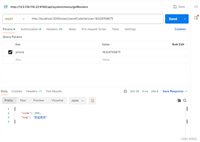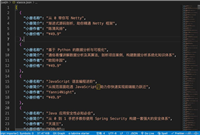如何在node.js项目中使用 swagger 来自动生成 api接口文档,使用生成方式有很多种。本文基于
swagger-jsdoc+swagger-ui-express快速实现
1、直接使用swagger-ui-express
// 方便来浏览和测试api npm i swagger-ui-express
import { express } from 'express';
import swaggerui from 'swagger-ui-express';
const options = {
openapi: "3.0.3",
info: {
title: '文档相关接口',
version: '1.0.0',
description: 'api documentation using swagger',
},
tags: [{
name: "develop",
description: "开发者站点管理接口",
}],
paths: {
"/develop": {
"get": {
"tags": ["develop"],
"description": "获取文档列表!",
"responses": {
"200": {
"description":"返回字符串数组"
}
}
}
}
}
}
const swaggerinstall = (app: express) => {
app.use(
'/apidoc',
swaggerui.serve,
swaggerui.setup(options)
);
};
export { swaggerinstall };

直接使用配置去生成接口文档,更改接口的时候需要同时去更改配置,会相对麻烦点。这时候就可以使用swagger-jsdoc,通过在接口上面注释信息后,就可以自动更新对应的api接口文档,其本质是通过读取该接口对应的注释,然后再转成对应的配置。
2、配合swagger-jsdoc
jsdoc 注释是一种特殊的注释语法,用于为 javascript 代码添加文档化和类型提示信息。它是基于 jsdoc 规范的一部分,旨在提供一种标准的方式来描述代码的结构、功能和类型信息
作用:接口文档注释有更新,对应的api文档会同步更新。确保接口变更,配置会同时去更改
npm i swagger-jsdoc
import { express } from 'express';
import path from 'path';
import swaggerdoc from 'swagger-jsdoc';
import swaggerui from 'swagger-ui-express';
const swaggeroptions = {
swaggerdefinition: {
info: {
title: '文档相关接口',
version: '1.0.0',
description: 'api documentation using swagger',
},
},
apis: [path.join(__dirname, './routes/*.ts')], // 指定包含 api 路由的文件或文件夹路径
};
const swaggerinstall = (app: express) => {
app.use(
'/apidoc',
swaggerui.serve,
swaggerui.setup(swaggerdoc(swaggeroptions))
);
};
export { swaggerinstall };
//在对应的接口,注释对应的文档
import express from 'express';
import {
developgetfile,
developgetfilelist,
} from '../controllers/developcontrollers';
const router = express.router();
/**
* @openapi
* /develop:
* get:
* tags: [develop]
* description: 获取文档列表!
* responses:
* 200:
* description: 返回字符串数组.
*/
router.get('/', developgetfilelist);
参考
https://github.com/surnet/swagger-jsdoc
https://github.com/scottie1984/swagger-ui-express
以上就是在node.js中使用swagger自动生成api接口文档的详细内容,更多关于node.js swagger生成api文档的资料请关注代码网其它相关文章!





发表评论